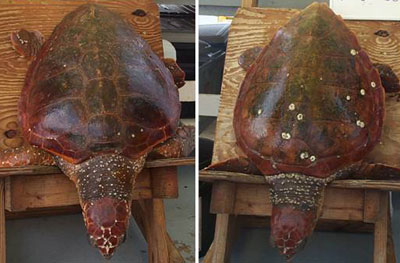Research - Population structure
In addition to providing an index of relative abundance over time, the physical capture of animals affords opportunity to study population structure, which is perhaps the greatest and most unique attribute of in-water surveys. The parameters of greatest importance for studying population structure are the distribution of turtle size, the ratio of females to males, and assessment of natal origin using genetic markers. Because sea turtles are not sexually dimorphic and because physical appearance is not a reliable means for identifying individuals from different breeding populations, sex is determined by circulating testosterone levels and natal origin through DNA.

Twins? Guess again. Although these two sea turtles were only 0.1 cm different, both female, and captured at the same location within six hours of each other, they possess two very different genetic haplotypes.
Although some of this information could also be obtained from dead or moribund sea turtles that strand along the coast, because of the opportunistic nature of strandings it may not be possible to generate enough samples in some years or locations to facilitate comparisons. Furthermore, because of the often deteriorated condition of stranded turtles, size and sex data may be severely compromised. Lastly, there is at least some possibility of recapturing a previously measured sea turtle tagged and released during the in-water survey, providing possible future data on growth rates. Noteworthy demographic findings from various in-water trawling efforts managed by the SCDNR MRD in the last two decades include the observations that:
- Loggerhead size distributions have steadily shifted towards larger juveniles; however, adult sizes continue to represent approximately 10–15% of all individuals captured.
- A greater proportion of adult male loggerheads captured from a breeding aggregation in the Port Canaveral were associated with smaller sizes than in the 1970’s and 1990’s, which could indicate recruitment of younger, more recently mature individuals.
- Sex ratio is female-biased, but differs among size classes (a proxy for age groups), which suggests that the proportion of females and males is cyclical in nature. This observation has profound implications for species conservation given that annual nest counts represent a proportion of the population that (a) can lay eggs (i.e., the females) and that (b) happen to be reproductively active in a given year.
- Female-biased sex ratio is twice as great in the Charleston, SC shipping channel as it is elsewhere off SC, and suggests that vessel strikes in this shipping channel are twice as likely to remove future nesting sea turtles from the population than in other habitats.
- Genetic data are skewed (89%) towards two haplotypes (CC-A01 and CC-A02) that are prevalent on nesting beaches in the Southeast U.S.; however, a pronounced decline in the prevalence of the CC-A02 haplotype occurs among adult loggerhead sea turtles, which likely represents a return to natal regions in south Florida where the CC-A02 haplotype is prolific among south Florida nesting sea turtles.
- A decline in haplotypes other than CC-A01 and CC-A02 is also associated with adult loggerhead sea turtles, despite the greatest relative abundance of these other haplotypes among loggerhead sea turtles nesting north of Florida. As such, the disappearance of these other haplotypes among adult loggerheads has been identified as an area where additional study is needed.
- Despite 99% of nesting near the US/Mexico border, Kemp’s ridley sea turtles captured between north Florida and South Carolina exhibit multiple genetic haplotypes.
